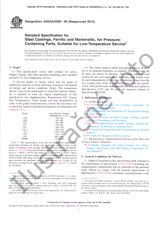Potrebujeme váš súhlas na využitie jednotlivých dát, aby sa vám okrem iného mohli ukazovať informácie týkajúce sa vašich záujmov. Súhlas udelíte kliknutím na tlačidlo „OK“.
ASTM G217-16
Standard Guide for Corrosion Monitoring in Laboratories and Plants with Coupled Multielectrode Array Sensor Method
NORMA vydaná dňa 1.11.2016
Informácie o norme:
Označenie normy: ASTM G217-16
Poznámka: NEPLATNÁ
Dátum vydania normy: 1.11.2016
Kód tovaru: NS-668517
Počet strán: 11
Približná hmotnosť: 33 g (0.07 libier)
Krajina: Americká technická norma
Kategória: Technické normy ASTM
Kategórie - podobné normy:
Anotácia textu normy ASTM G217-16 :
Keywords:
CMAS, corrosion monitoring, coupled multielectrode, coupled multielectrode array sensor, crevice corrosion, localized corrosion monitoring, on-line corrosion monitoring, pitting corrosion,, ICS Number Code 19.040 (Environmental testing)
Doplňujúce informácie
| Significance and Use | ||||||||||||||||||
|
4.1 Guide G96 describes a linear-polarization method and an electrical resistance method for online monitoring of corrosion in plant equipment without the need to enter the system physically to withdraw coupons. These two online monitoring techniques are useful in systems in which process upsets or other problems can create corrosive conditions. An early warning of corrosive attack can permit remedial action before significant damage occurs to process equipment. The two methods described in Guide G96 are suitable for uniform corrosion, but may not be sensitive enough for non-uniform corrosion, especially localized corrosion. This guide describes a new method for monitoring non-uniform corrosion, especially localized corrosion. 4.2 The CMAS technique measures the net anodic current or net cathodic current from each of the individual electrodes (Note 1: The upper section shows the electron flows from the corroding area to the less corroding areas inside a metal when localized corrosion takes place; the lower section shows the electron flows after the anodic and cathodic areas are separated into individual small electrodes and coupled through an external circuit that measures the anodic current (Iaex) and cathodic current (4.3 Unlike uniform corrosion, the rate of non-uniform corrosion, especially localized corrosion, can vary significantly from one area to another area of the same metal exposed to the same environment. Allowance shall be made for such variations when the measured non-uniform corrosion rate is used to estimate the penetration of the actual metal structure or the actual wall of process equipment. This variability is less critical when relative changes in corrosion rate are to be detected, for example, to track the effectiveness of corrosion inhibitors in an inhibited system. 4.4 The same as the method described in Guide G96, the CMAS technique described in this guide provides a technique for determining corrosion rates without the need to enter the system physically to withdraw coupons as required by the methods described in Guide G4. 4.5 The same as the methods described in Guide G96, the CMAS technique is useful in systems in which process upsets or other problems can create corrosive conditions. An early warning of corrosive attack can permit remedial action before significant damage occurs to process equipment. 4.6 The CMAS technique provides the instantaneous corrosion rate within 10 to 40 s making it suitable for automatic corrosion inhibitor dosing control. 4.7 The CMAS technique is an online technique and may be used to provide real-time measurements for internal corrosion of pipelines and process vessels, external corrosion of buried pipes and structures, and atmospheric corrosion of metal structures. |
||||||||||||||||||
| 1. Scope | ||||||||||||||||||
|
1.1 This guide outlines the procedure for conducting corrosion monitoring in laboratories and plants by use of the coupled multielectrode array sensor (CMAS) technique. 1.2 For plant applications, this technique can be used to assess the instantaneous non-uniform corrosion rate, including localized corrosion rate, on a continuous basis, without removal of the monitoring probes, from the plant. 1.3 For laboratory applications, this technique can be used to study the effects of various testing conditions and inhibitors on non-uniform corrosion, including pitting corrosion and crevice corrosion. 1.4 Units—The values stated in SI units are to be regarded as the standard. No other units of measurement are included in this standard. 1.5 This standard does not purport to address all of the safety concerns, if any, associated with its use. It is the responsibility of the user of this standard to establish appropriate safety and health practices and determine the applicability of regulatory limitations prior to use. |
||||||||||||||||||
| 2. Referenced Documents | ||||||||||||||||||
|
Odporúčame:
Aktualizácia zákonov
Chcete mať istotu o platnosti využívaných predpisov?
Ponúkame Vám riešenie, aby ste mohli používať stále platné (aktuálne) legislatívne predpisy
Chcete vedieť viac informácií ? Pozrite sa na túto stránku.




 Cookies
Cookies
